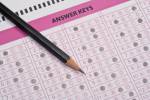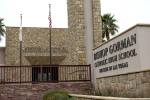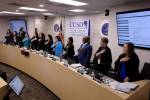Math tests carry shock factor
No more excuses.
As Clark County School Board member Terri Janison on Thursday reacted to the excessive rate of student failure on end-of-semester math exams, she made it clear that now's the time for change, not excuses.
She knows there have been complaints that students had too little time to take the tests.
She knows there's controversy over whether the test was implemented as intended in high school classes.
But as she looks at the average high school failure rates -- 90.5 percent in Algebra 1, 87.8 percent in Geometry and 86.6 percent in Algebra 2 -- she keeps coming back to one thought: Students who are taught math should know math.
"For the numbers to be this high, it just doesn't make sense to me," Janison said.
End-of-semester math exams developed to measure whether students were mastering concepts required by district standards were given for the first time in January. The preliminary results, published Wednesday in the Review-Journal, shocked everyone, including Superintendent Walt Rulffes.
Rulffes said the district voluntarily developed and administered the test, knowing the results might not be positive. But the results, even though they're disappointing, are a necessary step in improving math performance, reducing the level of student remediation required in college and meeting higher federal standards.
Deputy Superintendent of Instruction Lauren Kohut-Rost agreed.
"Quite honestly, we were not looking for stellar results," Kohut-Rost told board members during a regular board meeting.
Bill Hanlon, director of the Southern Nevada Regional Professional Development Center, helped create the exam. He was so shocked by the initial numbers that he called the district's assessment and accountability staff to have them recheck the numbers. When it became apparent the figures weren't a major error, Hanlon began asking district administrators what went wrong.
One of his most disturbing findings was that teachers are departing from required curriculum to review basic math skills, which means they aren't covering all the areas students need in the first semester. That can't be allowed to happen, Hanlon said, because it means students are getting passed on to higher math classes without crucial skills. It's a deficit that's compounded from year to year.
"The system can't survive if people don't make a good-faith effort," Hanlon said.
School district staff members are analyzing the results and forming strategies to address the problems. For School Board member Sheila Moulton, that can't happen fast enough.
"We're about to start the fourth quarter," Moulton said. "The year's over. What do we do in those last 40 days of school?"
Students will end the school year with another round of exams. This time, district officials hope for better results.
Contact reporter Lisa Kim Bach at lbach@reviewjournal.com or (702) 383-0287.























